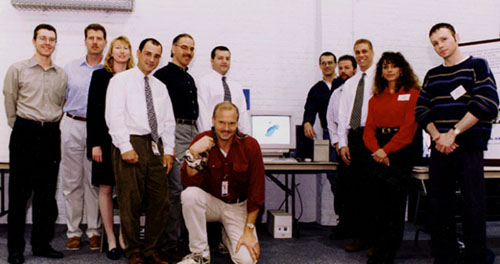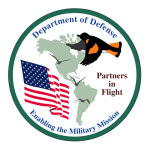NAVAL AIR ENGINEERING STATION LAKEHURST
ENVIRONMENTAL TEAM
SUBMISSION FOR
SECRETARY OF DEFENSE
ENVIRONMENTAL CLEANUP AWARD – INSTALLATION
INTRODUCTION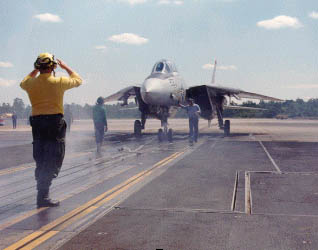
The Naval Air Engineering Station (NAVAIRENGSTA) is the Shore Station Management component of the Naval Air Warfare Center Aircraft Division Lakehurst. Collectively known as Navy Lakehurst, the organization’s mission is Aircraft Platform Interface, which is the safe effective operation of aircraft to, from, and on all aviation platforms. To accomplish this mission, Navy Lakehurst currently employs over 1900 civilian employees which consist primarily of engineers, technicians, logisticians, acquisition experts and manufacturing support specialists. In addition, Navy Lakehurst has approximately 230 military personnel. The Station also provides facilities and support services for tenant activities. NAVAIRENGSTA encompasses 7430 acres, including a 21 acre non-contiguous parcel, Pinehurst Estates, located in the Borough of Lakehurst. The complex contains 446 structures and 328 buildings totaling 2,845,731 square feet of floor space. Facilities include two 5,000 foot operational runways, a 12,000 foot runway equipped with catapult and arresting gear and five test tracks.
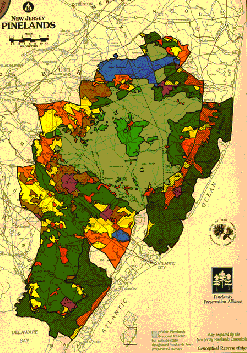
The Station and the surrounding area are located within the Pinelands National Reserve, the most extensive undeveloped land tract of the Middle Atlantic Seaboard. The Pinelands consists of a delicately balanced ecosystem and covers the largest drinking water aquifer in the Northeast. Subsequently, the Station’s groundwater is subjected to the strictest cleanup levels in the region. In 1985, the Station was the focus of a local environmental controversy, thought to be a polluter of the local community’s drinking and recreational water. This controversy led to numerous derogatory newspaper articles and even a chapter in the book The Threat at Home. This period in the Station’s history is an often remembered lesson that public outreach and education is a never ending mandate. Today the Station is lauded by regulators, environmental and community groups as an example of environmental excellence. Named to the National Priorities List (NPL) in 1987, our hard work has paid off; only 11 of the original 45 sites require further action and all have a remedy in place. NAVAIRENGSTA will start the NPL delisting process in early 1999.
BACKGROUND
Environmental Cleanup Challenges
The environmental team at Lakehurst has always treated obstacles as challenges to be met and avenues for new opportunities. Although all our sites are either completed or have active treatment in place, the Team
realizes there is always room for improvement. The Station has a number of contaminated groundwater areas. Currently we have 4 pump and treat facilities, and we monitor groundwater in four more areas. Most of our cleanup budget for the last five years has been spent on the operations and maintenance of our groundwater treatment facilities. Since their installation, it has become evident these systems have limited effectiveness, so one of our primary goals is to augment or find substitutions to this traditional pumping approach. In the past year we have made significant progress toward this goal by placing new pumping wells in better locations and installing dual phase recovery wells. We project saving many years of system operation costs with these improvements. We are also using sparging in strategic areas with the hope of turning off the groundwater systems in the near future. Although the treated water discharged from our systems meets primary drinking water standards, it does not meet the “natural background” Pinelands standard due to mineral removal and pH alteration; both which are necessary prior to air stripping. Therefore, turn-off of the treatment facilities will have both economic and environmental benefits.
Organization, Staffing, Management Approach
The environmental team is located within the Station’s Public Works Engineering Division. The Environmental Branch, consisting of nine engineers and one engineering technician, is led by Lucy Bottomley, P.E. Many of the engineers are Professional Engineers, six have master’s degrees and all are Registered Environmental Managers. Each engineer is responsible for one or more programs. Every engineer also has at one time been the lead project manager for a number of Installation Restoration sites.

The philosophy of the branch requires engineer to have total responsibility for their project. However, if a project fails, it is considered a failure for the whole team. Therefore, the project manager does not hesitate to call on coworkers for help. This blend of individual responsibility and teamwork is very successful and has become the natural way in which the environmental branch operates.
All engineers in the branch are encouraged to obtain their P.E. license and become certified Naval Facilities Engineering Command Design Managers. As Design Managers, engineers are versed in writing Architectural/Engineering (A/E) Services, construction and/or operations and maintenance contracts, for subsequent award through our on-base Contracts Offices. The engineer is responsible for managing and overseeing the day to day enforcement of these contracts. Although this method of local contracting is labor intensive for the Team, it pays off with less costly contracts and the ability to maintain strict quality control over the services and products we receive.

Community Involvement Programs
Adopt-A-School Program. The NAVAIRENGSTA environmental team continues to be involved in the Station’s Adopt-A-School program. During the summer of 1997, the environmental team hosted Manchester High School students who were attending an environmental camp. The students spent several days with environmental engineers learning about migratory birds, Pinelands snakes, water treatment and geographical information systems.
The students spent the mornings studying about these concepts at the Station and then applied their knowledge back at the high school. The environmental team also hosted two high school seniors for a semester who conducted a water quality analysis of two ponds located on the Station. The students conducted daily water tests, gathered data and conducted a literature search. This program enables the youth of the community to understand the need to help preserve the fragile Pinelands ecosystem as well as experience our environmental team’s dedication to this environment.
Earth Day Program. In FY97 the Environmental Team held its first Earth Day Exhibition on base. Since many of our public meetings are held in the evening and off-station, this session provided base personnel an extra opportunity to learn about our cleanup efforts and talk to the project managers. Our Environmental Protection Agency (EPA) case manager was also on hand to answer questions. Topics included unexploded ordnance safety procedures, the water cycle, and groundwater modeling and site characterization techniques.
Cleanup Plans, Schedules, Documents. The Station has never missed a Federal Facilities Agreement schedule deadline. In fact, the Station is often early with its submittals. In May 1997, final Records of Decision (RODs) were signed for 3 areas of groundwater contamination. Only one area remains requiring a final ROD. This one site is the subject of a three year natural attenuation study. The ROD for this site is scheduled for May 1999, and the Station will follow with its Delisting Report shortly thereafter. In-house contaminant transport modeling is now the focus of our environmental cleanup efforts, to accurately predict groundwater treatment completion times.

Mike Figura, demonstrates how
groundwater transports contaminants.
Initiatives. Initiatives over the last couple of years have been to optimize our soil and groundwater treatment facilities. Over half the equipment in our groundwater pump & treat facilities is dedicated to removing naturally occurring iron prior to air stripping of contaminants. Through in-situ treatment or natural restoration, these indirect cleanup costs can be avoided. We are using groundwater sparging and spraying to further reduce our dependency on groundwater pump and treat technology.
PROGRAM SUMMARY
Objectives and Degree of Success over preceding 2 Fiscal Years
a. Teamwide training in Groundwater Modeling. In 1997 the whole Lakehurst team received on-site DOD Groundwater Modeling System (GMS) instruction by the Army Corp of Engineers, Waterways Experiment Station. The GMS interface includes 3-D subsurface modeling, geostatistical interpretation and visualization, and MODFLOW� , MT3D� , MODPATH� and FEMWATER� interfaces. This teamwide training allows the Station to expand its already ongoing modeling and subsequent decision making.
b. Optimize our existing treatment systems. In 1997 we implemented a contract to install new recovery wells to optimize our four groundwater treatment systems and installed higher horsepower blowers at 2 of our bioventing/air injection systems.
c. Initiate Pilot Studies in alternative groundwater remediation technologies. Pilot studies for a sparge wall, a soil vapor extraction system, and a spray irrigation system at various contaminated groundwater areas were initiated in FY97. These pilot scale systems will provide design data for full scale systems scheduled for FY98.
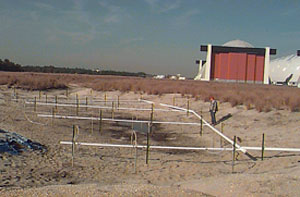
d. Reduce our operational sampling costs. Through negotiations with regulators, NAVAIRENGSTA has been permitted to reduce its groundwater monitoring requirements in half, resulting in a savings of approximately $150K/year. This reduction took effect in FY97 with the renewal of our Operations and Maintenance contract. Furthermore, the Station will save an additional $120K a year by reducing the number of sampling events at our 3 vapor extraction/ bioventing sites.
e. Remove cleanup liabilities associated with Ranges. In January 1997 our work with Installation Restoration (IR) Site 41, the ordnance impact area, convinced regulators that ordnance was not a source of environmental contamination. Consequently, Site 41 was delisted from the NPL by EPA. It continues to be addressed by the Station’s Safety program.
In 1997 the Station also closed and remediated its two small arms ranges: one a pistol range and the other a trap range. The soil was screened for bullets and for some portions of soil, gravity flotation was used to remove the smaller fractions of lead. Soil now meets the New Jersey Department of Environmental Protection (NJDEP) soil cleanup criteria.
ACCOMPLISHMENTS
Fast Track Cleanup (Base Realignment and Closure (BRAC) Bases Only). See section on Partnerships describing our cleanup work with a nearby BRAC base.
Innovative Technology Demonstration/Validation And Implementation
“The major thing that makes us good is that we don’t restrict ourselves… We don’t fit into any particular pattern… We don’t think we can’t do something.”
Natural Restoration. A large volatile organic compound plume (Areas I & J) was originally slated for remediation by traditional pump and treat technology in 1993. However, in 1994 during groundwater modeling of the site it was revealed that pumping of the plume may damage over 80 acres of wetlands. Through negotiations with the EPA and NJDEP, Lakehurst pursued and obtained a revised Record of Decision for Natural Restoration at the site. The use of natural restoration at this site is expected to save over $40 Million in construction and operations and maintenance costs. Our engineers have been asked to present the data and groundwater modeling approach for this site at numerous technical conferences. This project has also been featured at the 1996 International Symposium on Intrinsic Bioremediation, presented at the April 1996 Navy/Marine Corp Site Cleanup Conference, and this year’s 3rd Annual International Symposium on Natural Attenuation.
Lakehurst Natural Attenuation Project featured in the Engineering News Record.
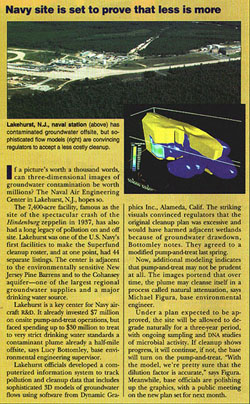
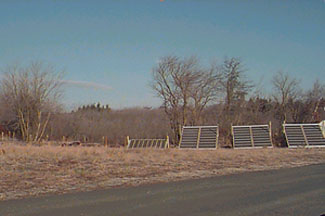
Solar Powered Groundwater Treatment. This year we have experimented with the use of solar power to run pilot scale air sparge wall and spray irrigation remediation systems. The panels were donated by the Naval Facilities Engineering Command. These systems were installed by our Public Works staff and began operation this past summer. Latest sampling rounds have shown significant reduction of volatile organic contaminants in the groundwater. Larger scale systems are slated for startup next year.
Environmental Information on the World Wide Web. By visiting our environmental website, it’s possible for citizens to look up NAVAIRENGSTA’s latest environmental cleanup information in seconds. Pictures and descriptions of contaminated sites are accessible by merely clicking on the
site number of our base map. Visitors can view our current projects, find out how we treat our groundwater, and get an up-to-date public meeting schedule. The website also allows the user to link to and access the EPA ROD database and the Defense Environmental Restoration Program Annual Report to Congress. The visitor can submit their name and address for inclusion on our IR community relations mailing list. They can also ask questions or submit recommendations for our website electronically. In FY97 we added our Technical Review Committee meeting minutes to our website, which were previously available only through the library repository or a special mailing list. Visit us at “http://www.lakehurst.navy.mil/envir/envir.html”
Partnerships Addressing Environmental Cleanup Issues. Naval Air Warfare Center (NAWC) Trenton – BRAC Site Cleanup. Lakehurst engineers have been partnering with the Naval Air Warfare Center Trenton for the past 3 years. As they prepare to close their doors forever, its environmental staff has dwindled to less than 25% of is pre-BRAC level. In the last year, Lakehurst has come to their aid by offering one of our engineers to work at their location on a part time basis. Previously Lakehurst provided a person to act as their BRAC Environmental Coordinator for a year. In FY97, the Lakehurst Team produced Decision Documents for eight of their dirty earth sites. These decision documents will enable the local re-use board to expedite land transfer. This partnership has been facilitated in that both Lakehurst and Trenton share the same NJDEP case manager, much of the same regulations and many of the same site cleanup issues.
Restoration Advisory Boards (RABs)
Over the years, the Station has fostered a level of environmental trust which has resulted in the community feeling confident about our cleanup efforts. There is often minimal community interest or response to our proposed actions. If you ask anyone in Ocean County, chances are they will say our Station does not require a RAB. However, recognizing environmental concern is a mercurial thing, and can come up quickly when a new issue arises, the Station adopted a modified RAB format. Our RAB is an open community meeting, regularly held in the evening at the local library, where questions and comments are fielded by the environmental branch head and the community co-chair (a member of the TRC and project manager with the Pinelands Preservation Alliance).
The original RAB concept is designed to deal with base cleanup issues only. However, this alternative format matches our branch’s philosophy: that the Station is part of a greater community, and every local environmental decision can impact our mission and quality of life for ourselves, our coworkers, and our neighbors.

In February 1996, as part of the Renew America National Teleconference on Environmentally Sustainable Communities, the Station hosted the first Ocean County environmental conference. Comprised of members of the local Chamber of Commerce, government officials, school groups, the NJDEP, and citizen activist groups, this meeting was the first of its kind in the county. So when the RAB concept was initiated, the branch decided it made sense to provide easy accessibility to our own environmental decisions, as well as provide what seemed to be missing in our community: a regular forum to discuss any and all environmental issues facing ourselves and our neighbors.
The RAB is often a forum in which the local newspaper can get Station response to a community issue. One recent community issue discussed at our RAB was the Toms River Childhood Cancer Study. As one of the many NPL sites in Ocean County, the Station was a potential target for environmental blame. With regard to the Cancer Study, the Station came equipped with articles, data and maps to explain in layman’s terms what the study was attempting to achieve. The community and the press have expressed satisfaction with the accessibility, informality, and effectiveness of this meeting format. In regard to the Cancer Study, the Station successfully used the RAB format to educate the public and eliminate the base as a source of concern.
“When I first got involved in the issue in 1987, there was no community group like the RAB. Cleanup at Lakehurst was ongoing and you would read about it in the papers, but you didn’t have a lot of knowledge. Now when you want answers, you can go to the RAB meetings. If there’s anything going on at the base, you can go at the scheduled time and talk to base personnel actually involved in it…… They give detailed answers to questions. It’s gotten the public positively involved. Having this very important interaction has stopped a lot of misinformation.
“Not only do you find out about cleanup operations on the base, you also find out information about what’s happening in the community. RAB meetings provide a great opportunity to speak individually to people with expertise in this area.
“The people from Navy Lakehurst are very involved, they live here, and they give back to the community. That’s reassuring. When you want answers to your questions, you want to hear from someone who lives here and will be here in the future. This forum provides great back-and-forth interaction.”
Opportunities for Small and Small Disadvantaged Businesses. The Station uses an 8-A (Small Disadvantaged Business) contractor for its largest cleanup contract, for the operations and maintenance of our four pump and treat systems. This contract with Aguilar and Associates is worth $1.5M a year. Combined with our annual groundwater monitoring contract, over three quarters of our annual contract IR budget goes to small business. The Operations and Maintenance of the four systems sustains approximately 4 man-years of contractor work and 1 in-house engineering position yearly.

REDUCING RISK TO HUMAN HEALTH AND THE ENVIRONMENT
Interim Actions: NAVAIRENGSTA has taken many interim actions over the years to protect human health and the environment. Our four pump and treat facilities, designed in-house, were some of the first in the Navy and were done under interim Records of Decision. As many installations are finding out, pump and treat is not the most efficient or cost effective method to remediate groundwater. So we have improved our existing systems to substantially reduce the amount of time they will have to operate. Additionally, in FY97, the Station implemented “solar sparging” and “solar spraying” to treat volatile organic contaminated groundwater.
Improvements in site management techniques: The key to our success has been hands-on, local site knowledge and project management. Therefore, training of our environmental staff is an on-going requirement. This past year the whole team was trained in the DOD’s Groundwater Modeling System and took the Registered Environmental Manager’s course. In FY97, the environmental team started writing the data interpretation reports for our bioventing systems and groundwater treatment facilities in-house (which were previously written by consultants). This report writing keeps the staff in-touch with the data and intimately knowledgeable about the sites so we can provide quicker response to regulator comments and questions.

Improvements in site characterization techniques: Our biggest characterization hurdle is determining the rate of natural biodegradation of our groundwater contaminants. Lakehurst is using groundwater modeling with extensive before and after data to factor out dispersion and determine actual rates of biodegradation. In year 2 of our 3 year natural restoration study, we will be comparing levels of volatile organic compounds in monitoring wells over time to determine biodegradation rates. These rates will then be “plugged” back into our groundwater model to find out how long it will take for levels to diminish to less than regulatory standards.
SUMMARY
The Environmental Team at Lakehurst takes pride in its role as a good neighbor to the community and to the environment it is pledged to protect. Our goal has always been to protect human health and the environment while providing the best value for the public’s money. Our highly trained and dedicated staff can and does conduct virtually all environmental functions in-house, avoiding time consuming and costly contracting methods. From engineering design of treatment systems to computer-aided groundwater modeling, there is almost no task this team cannot handle.
Our hands-on in-house approach to site management has allowed us to meet or exceed our Federal Facilities Agreement schedule time and again. The regulators express satisfaction with the speed in which we implement necessary actions and enjoy visiting our sites to see construction take place or even to help us trouble shoot problems. The partnership we enjoy with the regulators and the public allow us to quickly and efficiently pursue our common goals, avoiding confrontation and the bureaucracy associated with it. Because of this trust, the Station has been allowed to utilize low-cost, common-sense technologies and approaches not easily accepted at other NPL sites.
But don’t take our word for it. Here is what our EPA case manager has to say:
“Lakehurst is a good example of the community, the regulators, and the Navy getting together in a non-confrontational way realizing we have a mutual goal. Once we realized we had a mutual goal — cleaning up the environment at Lakehurst — we were able to get down to business and enter into a more trusting relationship. Once we all trusted each other, we felt more free to be frank in discussions which helped get the job done.
“For example, we were able to agree we could initiate interim actions. Specific levels were not set. We could see how the action performed. It would have taken a lot longer if we had to go through bureaucratic hurdles. We knew there was a problem and we knew what had to be done. We did the work up front, so cleanup levels became moot. We went straight to action we knew would work, then monitored it. It saved a lot of time and money.
“People can make or break a project. The people at Lakehurst are very enthusiastic. They really make a difference.”
